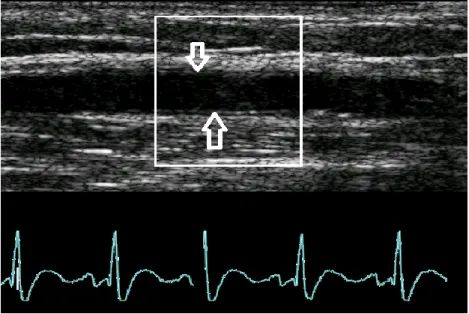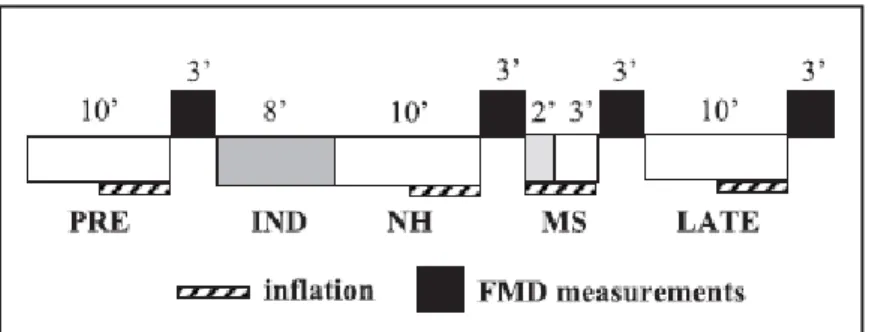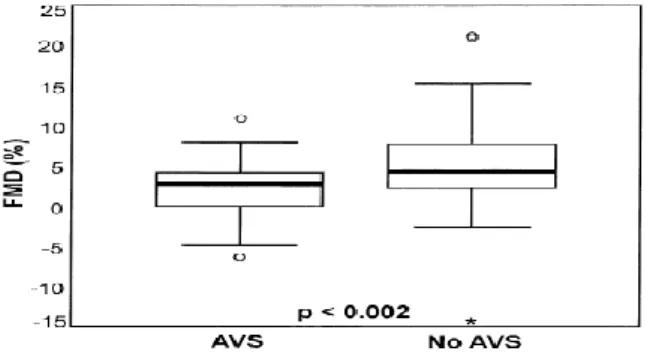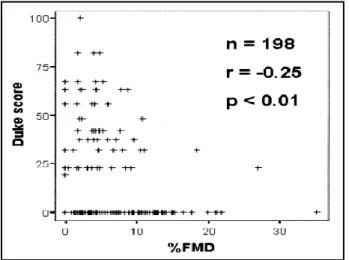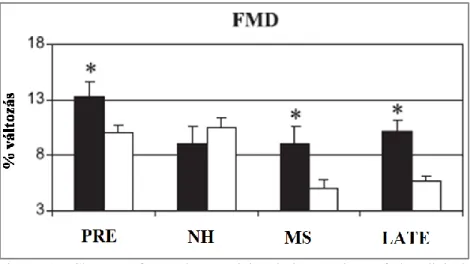The clinical impact of the non-invasive endothelial function measurements
PhD thesis Zoltán Jambrik, MD
Consultant: Prof. Béla Merkely, MD, PhD, DSc
Semmelweis University, School of Ph.D. Studies Ph.D. School: Basic Medicine
Head of the PhD School: Prof. László Rosivall, MD, PhD, DSc Program: Physiology and clinical aspects of heart- and vascular diseases Head of the Program: Prof. Béla Merkely, MD, PhD, DSc
Official reviewers: Prof. Viktor Bérczi, MD, PhD, DSc Róbert Sepp, MD, PhD, med. habil.
Theoretical exam committee: Prof. János Gál, MD, PhD (chair) Gábor Róbert Kiss, MD, PhD András Zsáry, MD, PhD Budapest
2011
2 INTRODUCTION
The prominent role of the atherosclerosis inthe pathophysiology of cardiovascular diseases is clear. The precise detection of the atherosclerotic lesions became a basal task of the cardiology in order to choose the optimal treatment.
The assessment of the vascular functions provides additional information.
The endothelial cells are able to control the vasomotor functions, the thrombocyte-aggregation, white blood cell adhesion and penetration, smooth muscle cell proliferation. The characteristic cardiovascular effect of the endothelial dysfunction is caused by the decreased nitric-oxide synthesis and/or impaired bioavailability.
Invasive vasomotor techniques (eg, quantitative coronary angiography and strain gauge plethysmography) are considered to be the diagnostic standard for the evaluation of endothelium-dependent vasodilation. However, patients cannot be frequently subjected to these invasive techniques as is needed in clinical applications and population-based studies. Therefore, brachial artery flow-mediated dilation (FMD) measurement by high-resolution ultrasonography is a broadly applicable method that is used for the examination of endothelial function. Both peripheral and coronary endothelial dysfunction may be induced by several risk factors, as in familial hypercholesterolemia,smoking,diabetes mellitus,and hyperhomocysteinemia.Coronary endothelial function has been found to correlate with endothelial function in accessible peripheral arteries, such as the brachial artery.A close relation has been demonstrated between FMD in
3
the brachial artery and the coronary circulation, both in terms of morphologic lesions and the functional responses to acetylcholine.
It is clear that the endothelial function have a very colorful importance in several clinical settings of the cardiovascular diseases. In our study, we find a useful correlation between the sclerotic degeneration of the aortic valve and the FMD measured by echocardiography. The study and the results are detailed in the following article
AIMS
At current thesis the following issues will be discussed in order to estimate the clinical importance of the non-invasive endothel function measurements:
1. the association between aortic valve sclerosis (AVS) and systemic endothelial manifestations of the atherosclerotic process in patients with known or suspected coronary artery disease (CAD), to prove our hypothesis on the association of aorta valve sclerosis with endothelial dysfunction
2. the potential usefulness of peripheral vascular reactivity noninvasively assessed by echocardiography in predicting angiographically assessed CAD in a large population of patients with typical or atypical angina and without previous myocardial infarction and/or revascularization procedures.
3. the prognostic value of ultrasonically assessed systemic endothelial dysfunction of patients with chest pain syndrome and to assess whether this information was incremental to that already provided
4
by simple parameters derived from echocardiography, such as LVMI or EF.
4. the effect of hypnotic induction on the acute vascular consequences of a mental stress.
PATIENTS AND METHODS
Correlation between endothelial dysfunction and aortic valve sclerosis A total of 102 in-hospital patients (76 men; mean age 63.5 ± 9.7 years) referred to the stress echocardiography laboratory underwent: 1) transthoracic echocardiography, with specific assessment of AVS (thickened valve leaflets with a transaortic flow velocity ≤ 2.5 m/s); 2) stress echocardiography; 3) coronary angiography, with evaluation of the Duke score (from 0 [normal] to 100 [most severe disease]); and 4) an endothelial function study, with assessment of endothelium-dependent, post-ischemic, flow-mediated dilation (FMD).
Endothelial function study.All patients were studied at least 4 h after their last meal, according to a standard protocol previously described in detail. Briefly, the patients were instructed to lie quietly in a supine position for 10 min before the study. All studies were performed in a temperature-controlled room (20 to 25°C). The diameter of the brachial artery was measured from two-dimensional ultrasound images. In each study, scans were taken at rest, during reactive hyperemia, at rest again, and after sublingual nitrate administration. The brachial artery was scanned in the longitudinal section, on the dominant arm, 2 to 15 cm above the elbow. The focus zone was set to optimize images of the lumen–arterial wall interface, and machine-operating
5
parameters were not changed during the rest of the study. The arterial diameter was measured at a fixed distance from an anatomic marker, such as a bifurcation. Measurements were taken from the anterior to posterior “m”
line at end diastole, incident with the R-wave on the ECG. Three cardiac cycles were analyzed for each scan, and measurements were averaged.
(Figure 1.) Following the baseline measurements, a pneumatic tourniquet was inflated below the elbow to a pressure of 250 mm Hg; forearm cuff occlusion was maintained for 4.5 min. Sustained maximal vessel dilation and maximal flow change occurred after 4.5 min of cuff occlusion; a higher cuff occlusion time does not provide a greater response. A shorter duration of cuff occlusion provides a less intense stimulus and fails to achieve sustained vasodilation 1 min after cuff release. Therefore, the arterial diameter was measured at 1 min after cuff deflation. After 10 min of vessel recovery, rest scan and flow measurements were repeated. Sublingual nitrate (0.3 mg glyceryl trinitrate) was then administered to evaluate endothelium-independent vasodilation.
The last set of scans was performed 3 min after nitrate intake. Endothelium- dependent, post-ischemic FMD was determined by the maximal brachial arterydiameter after exactly 60 s of reactive hyperemia, compared with the baseline vessel diameter, and was expressed as percent FMD. Endothelium- independent peripheral (nitrate medicated dilation) vasodilation is expressed as the percent change in brachial artery diameter 3 min after sublingual nitrate administration, using the baseline rest diameter as a reference. Intra- and inter-observer variabilities in our laboratory have been evaluated at 2.5%
and 2.0%, respectively
6
Figure 1.: Ultrasound measurement of the diameter of brachial artery.
(Arrows indicate the intimal surfaces of the vessel.)
Peripheral vascular endothelial function testing for the diagnosis of coronary artery disease
One hundred ninety-eight in-hospital patients (age, 59± 9 years; 78 women) with chest pain syndrome and without previous myocardial infarction or revascularization procedures were enrolled in the present study. All of the patients, at testing time, were not receiving nitrate therapy and underwent, on different days, coronary angiography and endothelium-dependent FMD testing of the brachial artery by high-resolution ultrasound. The result of the flow-mediated dilation is defined as the percent change in the internal diameter of the brachial artery during reactive hyperemia related to baseline(%FMD). A coronary vessel was considered to have a significant
7
obstruction if its diameter was narrowed by 50% or more on quantitative computer-assisted analysis. A prognostically validated angiographic Duke score (from 0=normal to 100= severe left main disease) was calculated.
The prognostic value of systemic endothelial function in patients with chest pain syndrome
One hundred ninety-five in-hospital patients (age=60±10 years; 63 females) with known or suspected CAD have been enrolled. All of the patients underwent, on different days, coronary angiography, endothelium-dependent FMD testing of the brachial artery by high-resolution ultrasound and resting 2D-echocardiography evaluation. The result of the FMD has been defined as the percent change in the internal diameter of the brachial artery during reactive hyperemia related to baseline. All patients were followed-up for a median of 27 months.
Hypnotic modulation of flow-mediated endothelial response to mental stress
Seventeen healthy volunteers (7 females, 10 males, age 19–35) were selected according to their hypnotic susceptibility through the Stanford Hypnotic Susceptibility Scale, form C among 97 participants. Subjects were divided into two groups: 8 high (Highs, score 9–12/12) and 9 low hypnotizable individuals (Lows, score 0–2/12).
Experimental sessions were undertaken between 9:00 and 11:00 a.m., at least 4 h after the last meal, in a semi-darkened, sound-attenuated and temperature controlled room (20–25 8C), with subjects in a semireclined position. Two experimenters were sitting nearby. All sessions were preceded by a 10-min
8
period, not included in the study, to obtain the stabilization of autonomic parameters and the familiarization of subjects with the experimental setting.
The recording session (Figure 2.) consisted of four periods: (1) a baseline (PRE, 10 min), without anyspecific instruction, with open eyes; (2) a neutral hypnosis (NH, 10 min) following a standard hypnotic induction, with eyes closed; (3) a period (MS, 5 min) including a mental stress of 2 min duration at its beginning, with eyes closed; (4) a later post-stress period (LATE, 10 min), with open eyes, after a standard awakening procedure. During NH no suggestion was given, except relaxation. MS consisted of serial subtraction and multiplication. In order to induce a higher level of stress subjects were falsely told that the results of their computation would be compared to FMD values to evaluate their logical attentive capabilities.
Figure 2. The design of the clinical experiment on the effect of hypnosis on stress-mediated vascular function
RESULTS
Correlation between endothelial dysfunction and aortic valve sclerosis
9
Aortic valve sclerosis was present in 35 patients (group I) and absent in 67 (group II). Groups I and II were similar in terms of the frequency of stress- induced wall motion abnormalities (35.3% vs. 19.4%, p ≤ NS) and the angiographic Duke score (33.8 ± 28.6 vs. 35.2 ± 29.1, p : NS). Patients with AVS showed a markedly lower FMD than those without AVS (2.2 ± 3.5%
vs. 5.3 ± 5.3%, p ≤ 0.01). On multivariate analysis, only FMD was highly predictive of AVS, with an odds ratio of 1.18 for each percent decrease in FMD (95% confidence interval 1.05 to 1.32; p ≤ 0.01).
Figure 3. Difference in endothelial function between patients with (“AVS”) or without (“No AVS”) aortic valve sclerosis
Peripheral vascular endothelial function testing for the diagnosis of coronary artery disease
The %FMD was lower in patients with (n=69) compared with those without (n= 129) coronary artery disease (4.64%±4.36% vs 7.39%± 5.68%; p<0 .01).
By multivariate analysis, the %FMD (p<0 .01; odds ratio [OR], 1.13; 95%
confidence interval [CI], 1.05 to 1.23), male gender (p<0 .01; OR, 3.47; 95%
CI, 1.64 to 7.36), and cigarette smoking habit (p<0 .01; OR, 4.00; 95% CI,
10
2.50 to 6.35) were independent predictors of CAD. %FMD was poorly albeit significantly correlated with the severity of CAD (%FMD Duke score, p<0 .01, r =-0.25) (Figure 4.). The receiver operator characteristic curve showed the %FMD optimal cutoff value as ≤ 8.84, with sensitivity of 90%, specificity of 37%, negative predictive value of 90%, and positive predictive value of 43%.
Figure 4. Poor correlation of endothelial function and Duke score
The prognostic value of systemic endothelial function in patients with chest pain syndrome
During follow-up there were 17 deaths (9 cardiac), 4 non-fatal myocardial infarction, and 18 late clinically-driven revascularization procedures. By a multivariate analysis, echocardiographically assessed ejection fraction (odds ratio: 2.32; 95% confidence interval: 1.24–4.33; p=0.008) and
11
angiographically assessed CAD (odds ratio: 2.82; 95% confidence interval:
1.40–5.67; p=0.003), were independent prognostic predictors of events. In patients with known or suspected CAD, systemic endothelial dysfunction did not show a significant prognostic.
Hypnotic modulation of flow-mediated endothelial response to mental stress
FMD changes were different across the session in the two groups (Figure 5.).
Repeated measures ANOVA revealed a Group [ F(1,15)=4.87, p<0.043] and a Condition effect [ F(3,45)=15.61, p<0.0001; e=0.903] as well as a Condition_Group interaction [F(3,45)=6.84, p<0.001; e=0.903]. FMD of Highs was significantly higher that Lows’ in PRE [ F(1,15)=5.36, p<0.035, MS[ F(1,15)=6.28, p<0.024] and LATE conditions [ F(1,15)=16.86, p≤0.001]. Follow-up analysis yielded a Condition effect in both Highs [ F(3,21)=5.353, p<0.011, e=0.831] and Lows [ F(3,24)=21.104, p<0.0001, e=0.750]. In Highs, contrast analysis revealed that in all conditions FMD was significantly lower than in PRE, with no significant difference in MS with respect to NH, while in Lows both MS and LATE were significantly lower than PRE and NH. No Gender effect was found. No significant difference was detected in the FMD control group over time.
12
Figure 5. Changes of vascular reactivity during sessions of the clinical experiment in Highs (black columns) and Lows (white columns).
CONCLUSIONS
From the results of the above mentioned clinical observations, the following conclusions can be originated:
1. Aortic valve sclerosis is associated with systemic endothelial dysfunction. This observation may provide a mechanistic insight into the emerging association between AVS and cardiovascular events.
2. Flow-mediated vasodilation has a weak capability to predict CAD, and it shows a poor correlation with the severity of the disease. The bottom line is that FMD is of limited value in noninvasive identification of CAD in the individual patient;
however, in group analysis, peripheral arterial endothelial
13
dysfunction is often associated with electrocardiographic or scintigraphic signs of ischemia during stress testing. On the contrary, wall motion abnormality during stress testing is unrelated to peripheral endothelial dysfunction,probably because echocardiographic positivity requires epicardial artery stenosis, and it is not evoked by pure microvascular abnormalities. At present, in patients with known or suspected CAD and peripheral vascular endothelial function, testing remains a research-oriented, pathophysiologically appealing tool in the echocardiographic laboratory, with the potential to offer an individual biological dosimeter of risk exposure through endothelial function, especially appealing in the early stages of atherosclerosis. There is, however, no clear clinical role in noninvasive prediction of CAD that represents true diagnostic challenges.
3. In patients with known or suspected CAD, systemic endothelial dysfunction did not show a significant prognostic value.
Echocardiographic indices of structural left ventricular damage appear to have a stronger prognostic value than functional indices of peripheral vascular damage in risk stratifying ischemic patients. At present, in patients with known or suspected coronary artery disease, peripheral forearm testing remains a research-oriented pathophysiologically appealing tool in the echocardiography laboratory, with the potential to offer an individual biological dosimeter of the exposure risk through endothelial function, especially appealing in the early stages of atherosclerosis.
14
4. during hypnosis high hypnotic susceptibility prevents the acute stress-related endothelial dysfunction, similar to what was previously observed in highly hypnotizable subjects during wakefulness. However, regular practice of hypnotic relaxation could work as a conditioning method for the elicitation of spontaneous relaxation responses in daily life. Thus, it could be effective in contrasting the long-term effects of stress on cardiovascular system.
15 PUBLICATIONS
Publications related to the PhD dissertation
1. Poggianti E, Venneri L, Chubuchny V, Jambrik Z, Baroncini LA, Picano E: Aortic valve sclerosis is associated with systemic endothelial dysfunction. J Am Coll Cardiol. 2003;41:136-41.
2. Jambrik Z, Santarcangelo EL, Ghelarducci B, Picano E, Sebastiani L: Does hypnotizability modulate the stress-related endothelial dysfunction? Brain Res Bull. 2004;63:213-6 3. Jambrik, Z, Venneri, L, Varga, A, Rigo, F, Borges, A, Picano,
E. Peripherial vascular endothelial function testing for the diagnosis of coronary artery disease. Am Heart J 2004;148:684- 689
4. Jambrik Z, Sebastiani L, Picano E, Ghelarducci B, Santarcangelo EL. Hypnotic modulation of flow-mediated endothelial response to mental stress. Int J Psychophysiol.
2005;55:221-227
5. Jambrik Z, Chunzeng L, Santarcangelo EL, Sebastiani L, Ghelarducci B, Picano E. Traditional acupuncture does not modulate the endothelial dysfunction induced by mental stress.
Int J Cardiovasc Imaging. 2004;20:357-362.
6. Jambrik Z, Santarcangelo EL, Rudisch T, Varga A, Forster T, Carli G. Modulation of pain-induced endothelial dysfunction by hypnotisability.Pain. 2005;116:181-186.
7. Venneri L, Poggianti E, Jambrik Z, Varga A, Palinkas A, Picano E. The elusive prognostic value of systemic endothelial
16
function in patients with chest pain syndrome. Int J Cardiol.
2007;119:109-111.
Other publications
1. Gyöngyösi M, Pokorny Gy,Jambrik Z, Kovács L, Kovács A, Makula É, Csanády M. Cardiac manifestation in primary Sjögren's syndrome. Ann Reum Dis 1996;55:450-454.
2. Gyöngyösi M, Takács T, Czakó L, Jambrik Z, Boda K, Farkas A, Forster T, Csanády M. Noninvasive monitoring of hemodynamic changes in acute pancreatitis in rabbits. Dig Disease Sci. 1997;42:955-961
3. Gyöngyösi M, Kaszaki J, Németh J, Mojzes L, Wolfárd A, Jambrik Z. Acute myocardial infarction enhances the portal venous histamine level in dogs. Inflammation Research 1997;46:253-259
4. Gyöngyösi M., Takács T., Jambrik Z., Boda K., Czakó L., Csanády M.: Pancreasbetegséghez társuló cardiovascularis eltérések. Orv Hetilap 1997;30:1897
5. Gyöngyösi M., Jambrik Z., Takács T., Czakó L., Mojzes L., Boda K., Forster T., Csanády M.: Kísérletes akut pancreatitis okozta haemodynamikai változások noninvazív monitorizálása.
Card Hung 1998;1:5-12
6. Gyöngyösi M., Takács T., Czakó L., Jambrik Z., Boda K., Farkas A., Forster T., Csanády M.: Hemodinamikai változások nem invazív monitorizálása akut pancreatitises nyulakban. Lege Artis Med. 1999;9:213-14
17
7. Jambrik Z, Gyöngyösi M, Varga L, Forster T, Csanády M, Rostás L. Diastolic parameters change during dobutamine stress echocardiography. Are these changes predictable for the diagnosis of ischemic heart disease? Cardiovasc. Imaging 1999;11:51-55.
8. Jambrik Z., Rostás L.:Supraventricularis tachycardiát utánzó széles QRS tachycardia differenciál diagnosztikája transoesphagealis EKG-val. Card Hung 1999;6:288-292 9. Jambrik Z., Gyöngyösi M., Varga L., Forster T., Rostás L.,
Csanády M.: A szív diastolés funkciójának változása dobutamin terhelés alatt- felhasználható-e az ischaemiás szívbetegség diagnosztikájában? Card Hung 2000;4:221-226
10. Jambrik Z, Gyongyosi M, Hegyi P, Czako L, Takacs T, Farkas A, Mandy Y, Gog C, Glogar D, Csanady M: Plasma levels of IL-6 correlate with hemodynamic abnormalities in acute pancreatitis in rabbits. Intensive Care Med. 2002;28:1810-8.
11. Palinkas A, Jambrik Z, Varga A, Forster T, Csanady M: Role of echocardiographic assessment of the left atrial appendage in clinical practice. Orv Hetil. 2003; 144:231-9.
12. Jambrik Z, Monti S, Coppola V, Agricola E, Mottola G, Miniati M, Picano E: Usefulness of ultrasound lung comets as a nonradiologic sign of extravascular lung water. Am J Cardiol.
2004;93:1265-70.
13. Avramov, K, Sztiha, L, Makai, A, Jambrik, Z, Rudas, L, Vécsey, L. Mechanism of cough syncope. Orv Hetilap 2004;145:1625-1627
18
14. Jambrik Z, Derchi G, Picano E, Ait-Ali L, Forni G, Bellotti P.Lack of prognostic value of normalized integrated backscatter analysis of myocardium in patients with thalassemia major: a long-term follow-up study.Echocardiography. 2005;22:239-244.
15. Bedetti G, Pasanisi EM, Tintori G, Fonseca L, Tresoldi S, Minneci C, Jambrik Z, Ghelarducci B, Orlandini A, Picano E.
Stress echo in chest pain unit: the SPEED trial. Int J Cardiol.
2005;102:461-467.
16. Ruzsa Z, Ungi I, Horváth T, Sepp R, Zimmermann Z, Thury A, Jambrik Z, Sasi V, Tóth G, Forster T, Nemes A. Five-year experience with transradial coronary angioplasty in ST- segment-elevation myocardial infarction. Cardiovasc Revasc Med. 2009;10:73-79.
17. Merkely B, Jambrik Z. [Drug-eluting balloon in the treatment of a recurrent in-stent restenosis of drug-eluting stent.] Orv Hetil. 2010;151:1509-1514.
18. Jambrik Z, Gargani L, Adamicza A, Kaszaki J, Varga A, Forster T, Boros M, Picano E. B-Lines Quantify the Lung Water Content: A Lung Ultrasound Versus Lung Gravimetry Study in Acute Lung Injury. Ultrasound Med Biol. 2010;
36:2004-10
